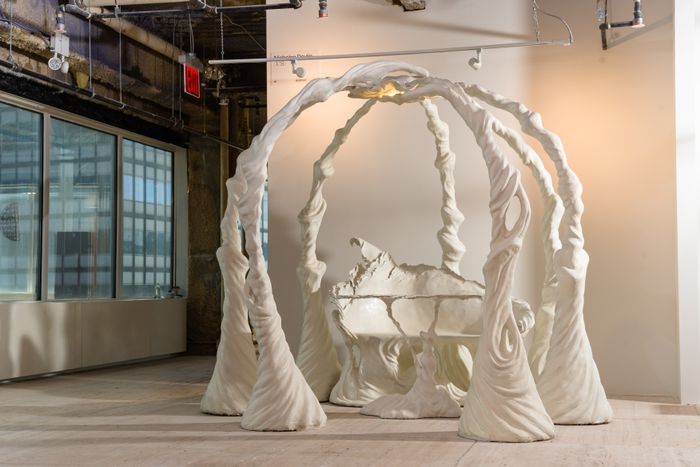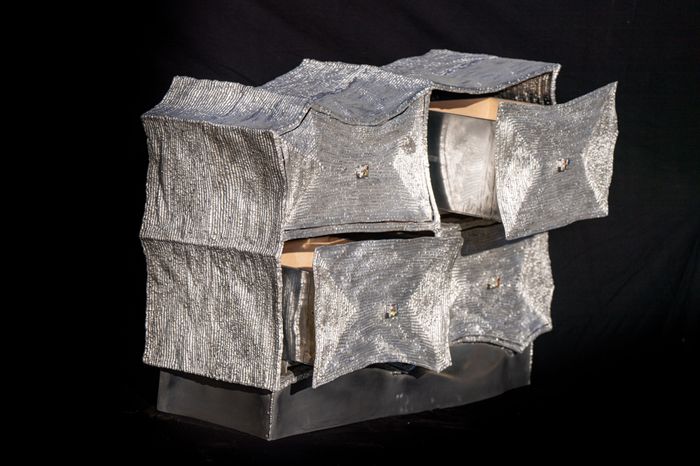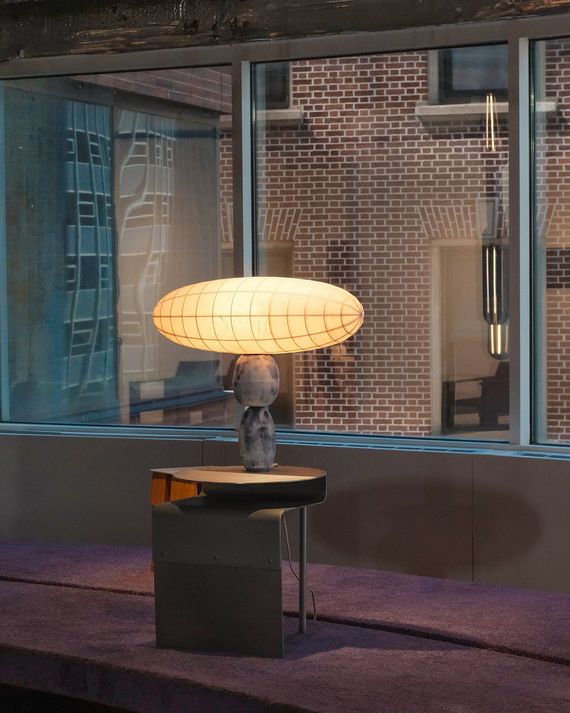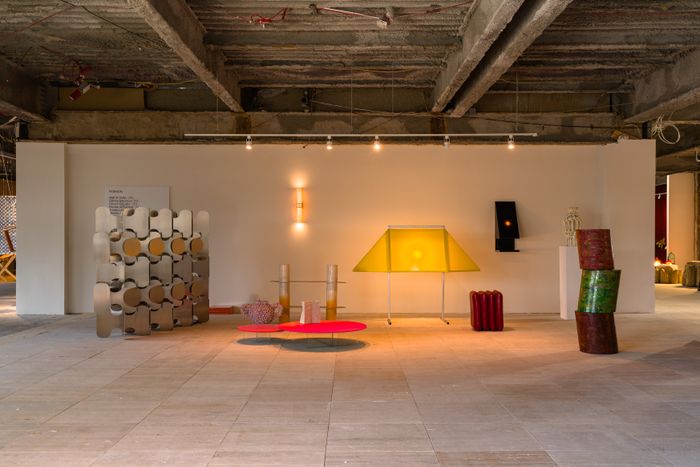
After seven successful runs in its native Brussels, the Collectible design fair makes its American debut this weekend. It picked a fittingly hip venue: Fidi’s adapted office high-rise with a wait list — the WSA building on Water Street. There, under the exposed industrial I-beams and wiring, more than 100 galleries and designers are spread across its third and fourth floors. The venue’s likeness to the fair’s home base (a modernist retail building turned museum) was a deciding factor in the New York launch, co-founders Clélie Debehault and Liv Vaisberg said. And thankfully it has little resemblance to the Javits Center.
Beyond the fair’s “no historical, no brands, no vintage” restrictions, the focus is on concept-driven, unique, and one-off design works. This 21st-century focus shows a clear snapshot of design today: There’s less formalism and staying in your lane, with furniture by fashion designers and architects doing industrial design (a path so well-trodden they have their own category: “ARCHITECT ⇔ DESIGNER”). While the fair’s sections were not always easy to parse — with categories like Bespoke, New Garde, and Curated — its fairly concise selection against the venue’s raw finishes offered a brutalist intimacy to the viewing experience. There was a lot of meticulously crafted wood on display, patchworked and grooved, alongside metal that was sculpted, pulled into hairs, draped as chain mail, even stacked and jigsawed together in large-scale pieces. Then there were artists who turned to the natural world and its processes, with a table of leaves and fungus that was made to decompose and a sculptural bird-house cabinet made from eggshells. What follows are a few selections that stood out.
Nicholas Devlin’s Fantastical Plaster Gazebo
Few could hear “giant strawberry” as their brief for a functional outdoor sculpture and return with a seven-armed ivory gazebo, fitted with overhead light and a sculpted bench and table. “An inhabitable surrealist strawberry” was what Nicholas Devlin said he took from his client’s direction and ran with. The hand-sculpted, reinforced plaster sculpture is a twisting concoction that seems like it might float away despite its scale and weight. In a fair full of solid, chunky forms and industrial materials, Devlin’s Alchemist’s Folly appears ethereal. With two works at Collectible and other striking commissions, Devlin continues to build a distinct fantasyland full of details that are worth looking at up close.
A New Chinatown Gallery’s Chair Lineup
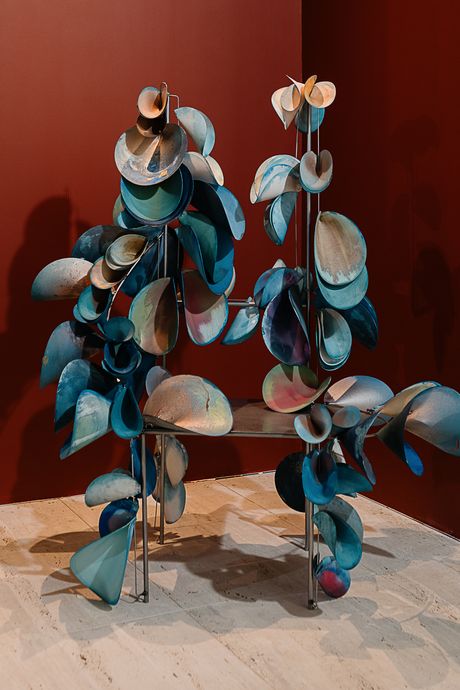
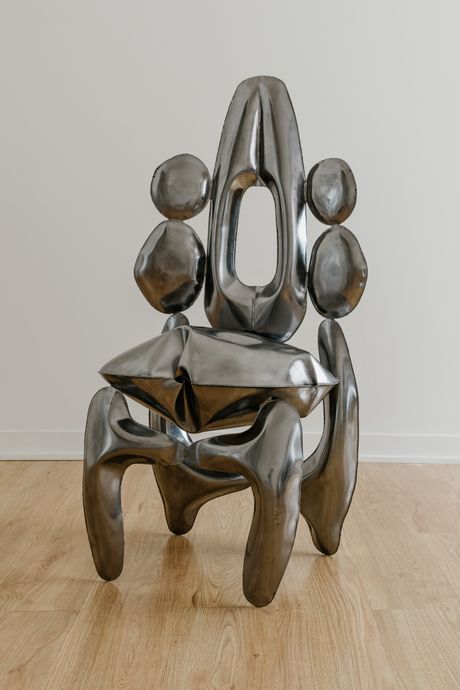
Five months-ago Lyle Gallery launched its Chinatown space with a group show “Metal,” exhibiting designs made out of said material. In its deep red booth at Collectible (painted by the married co-founders just hours before), they brought some of the artists from their opening show back, with a focus on their chairs. But Karina Sharif is a new name, and her peacock-like chair is captivating; it fans out dyed cotton paper along its solid steel frame; those delicate shell shapes in deep blues allude to the water that the artist (a former fashion designer) wanted to reference. Michelle Jiaxin Huang’s compressed steel chair, somewhere between a metal airbag and a paper cutout of a chair, seems to float. In making its Bone Chair, London design duo By Jamps used a pool noodle to cast its aluminum legs, between which it’s draped an intricate woven metal seat that resembles something you might see slung over a taxi driver’s car seat.
A Console-Hardware Collaboration by Petra x Sight Unseen
It takes aluminum, heat, filler rods and a lot of Jesse Groom’s time to make his Cicatrix console. But at Petra x Sight Unseen’s booth, the wonky, webbed console looks worth the nearly 200 process hours it took. The console is held together with many individually hand-welded lines, and flimsy aluminum sheets allow ripples to form and warp along the edges before Groom welds over the body to reinforce the structure. “Each bead not only makes marks like a drawing but also deforms the aluminum into something more like fabric, or even skin,” the upstate New York–based designer said. The console drawers are paired with colored stone knobs by The Perfect Nothing Catalog, which are encrusted with stones, shells, and sometimes gems by the artist Frank Traynor, who collects them himself.
Beehive and Dried Flower Lamps at Jack Simonds
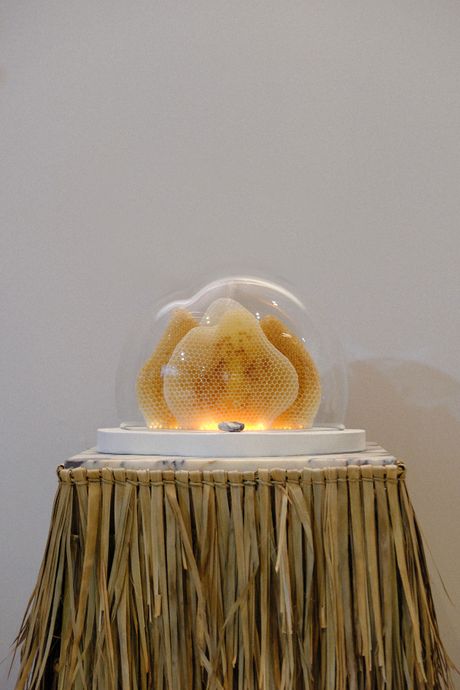
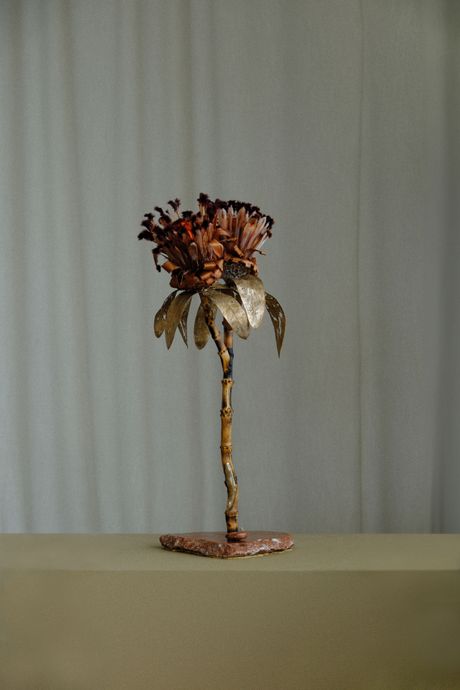
Jack Simonds takes more than just inspiration from nature in creating his pieces; he incorporates real flowers, plants, and beehives into them. Because of how fragile these materials are, the artist had to wait a long time to ensure his lamps and furniture could survive over time (they can, after a drying process, he says). Organic matter may not be for everyone, but few catch a glance of his beehive lamp or dried-plant lights without stopping to inspect them. A table lamp with a plant head, leaves of bronze cast from the plant’s original, and a burnt bamboo stem sprouting from a slab of veined red marble might look too delicate to function, but it gives off a muted glow and looks almost alive.
Soil Partitions and Interlocking Tables From Indian Designers
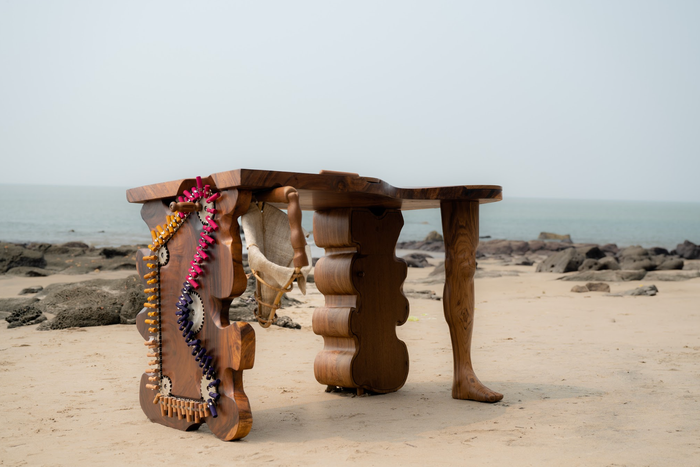
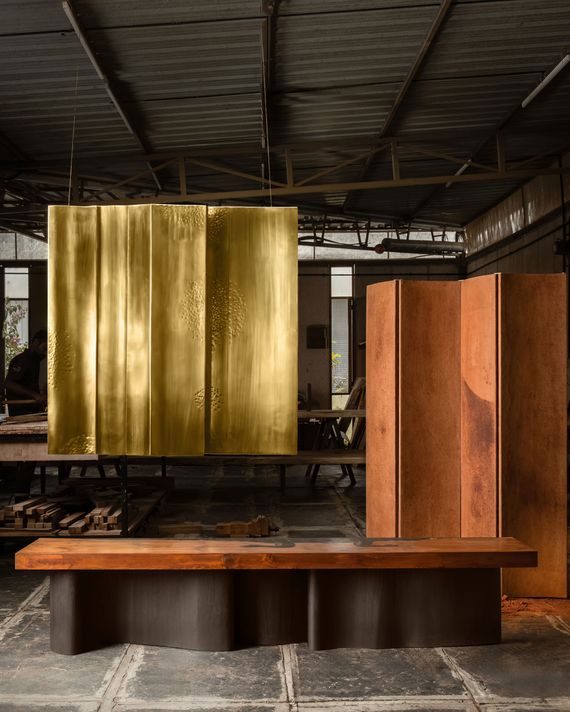
India’s flourishing collectible design scene was represented at Collectible by Bangalore-based studio The Vernacular Modern. Architect Abhirup Dutta and interior designer Deeptashree Saha created a three-tiered wall partition with a richly textured terra-cotta portion made from soil and inspired by sustainable mud homes found in rural India. Elsewhere in this section, a wooden leg carved in the likeness of a human leg was actually one of the last things I noticed about a desk of interlocking elements that resembled the inner workings of a watch. What initially caught my eye were the gem-colored chalk stems threaded through a metal chain on its side (which are in fact incense). Its maker, Indian-born New York–based architect Swati Jain (a.k.a. Unown Space) tells me the piece, Table on a Walk, is intended to embody the five natural elements, and it completely dismantles into separate parts, including pull-out trays, a basket, and a side table with handle.
Zeppelin Lamps by Vy Voi Studio
Perched on a floating island of deep purple carpet, a paper lamp by New York–based design studio Vy Voi glowed warmly on its porcelain totem base. The contrast between the narrow base and the delicate paper zeppelin on top is typical for designer Steffany Trần. Her gravity-challenging lights appear twice at Collectible — once in WSA’s own section, curated by South African designer Mzwakhe Ndlovu, and another at Erria, an online directory for emerging designers. Partially based in Ho Chi Minh, Trần works with local artisans to create the structural lantern tops from Dó paper, an 800-year-old material that has deep roots in Vietnamese folk art. Other lamps in the show also used simple materials to big effect, Freddy Tuppen’s cotton string and aluminum lamp and Tino Seubert’s wicker floor lamp. Also hard to forget: the angel lamp (also in WSA’s presentation), by “garbage specialist” designer Madeline Isakson.
A Fungal Table by Fefo Studio x Kamilla Csegzi
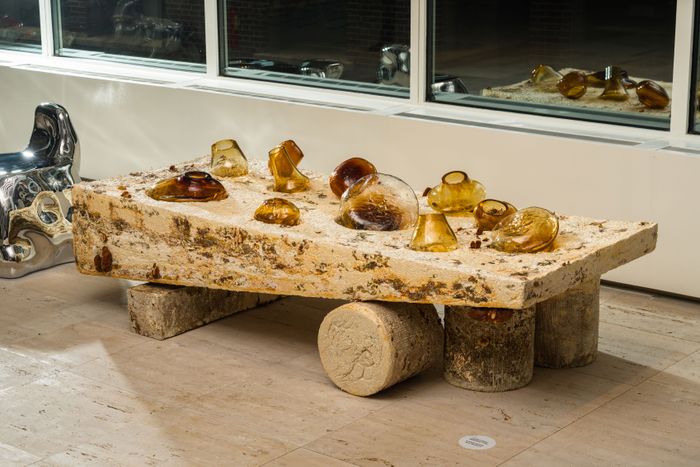
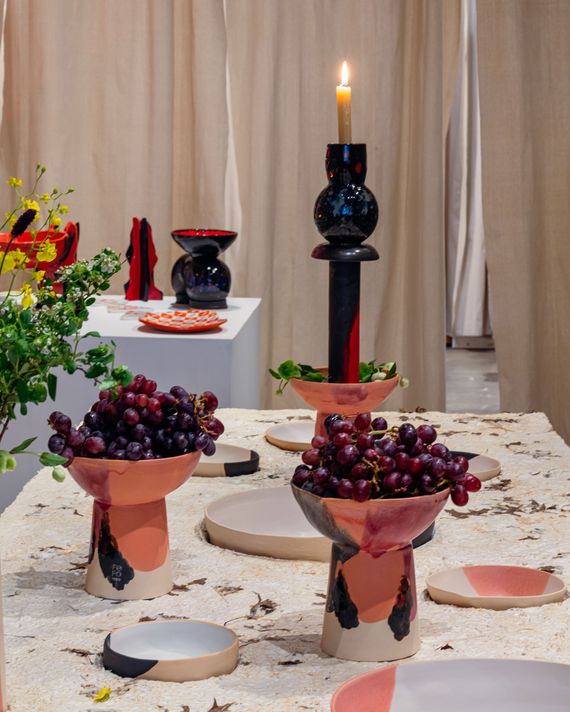
Rarely does anyone think about the life cycle of a table. But Fernando Aciar and Kamilla Csegzi’s Ephemeral Table is designed to decompose. The collaborative project between New York-based artist and chef Aciar and designer Csegzi is made of mycelium (a root-like fungus that takes the form of any mold it’s grown in) combined with leaves, leftover cardboard, and corn husks. The designers then molded it from the casting tables in their studios. The table is designed to appear in three acts: Act I was a dinner at event space OStudio, its Collectible showing is Act II, and next year in May, Design Week is the third. For Collectible (Act II), bowls and plates were used to mold and sculpt the table, creating the indentations that are now filled with amber glass vessels imprinted with the textures of the table’s surface. As the piece continues to degrade, it will in essence be a different work every day.
Related
- Steel Ribbon Benches, Wiggle Chairs, and More Design Finds
- Ruffled Vases, Chaises Longues Made of Pipes, and More Design Finds
- Blocky Face Ceramics, Brazilian Modernism, and More Design Finds


